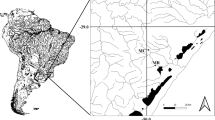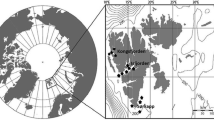Synopsis
The reproductive biology of eastern sea garfish Hyporhamphus australis, eastern river garfish H. regularis ardelio, and snub-nosed garfish Arrhamphus sclerolepis were described throughout their respective ranges in the coastal waters of New South Wales (NSW), Australia. Peaks in gonadosomatic indices indicated that spawning of eastern sea garfish occurred in late spring and early summer (November–December) on the south coast of NSW, and in winter and early spring (June–September) on the north coast. Eastern river garfish spawned between July and December in NSW estuaries and snub-nosed garfish spawned between October and January in the Clarence River. The sex ratios in commercial catches of eastern sea garfish from the north coast of NSW were biased toward male fish, but approached equality for fish caught from the south coast. Sex ratios were significantly biased toward female snub-nosed garfish, and female eastern river garfish from all estuaries sampled. Mean (±SE) batch fecundity was 1498 ± 110 (range: 98 – 3449) ripe oocytes per female for eastern sea garfish, 917 ± 36 (range: 102 – 2268) ripe oocytes per female for eastern river garfish, and 716 ± 104 (range: 20 – 2956) ripe oocytes per female for snub-nosed garfish across the range of mature sizes examined. There was a linear relationship between batch fecundity and fish size for all three species of garfish. Eastern sea garfish approached 50% maturity at a larger size than snub-nosed, or eastern river garfish. Size at 50% maturity was similar for male and female eastern river and snub-nosed garfish, but male eastern sea garfish matured at a significantly smaller size than females. All three species appear capable of spawning in the spawning season immediately following the one in which they were born. Mature female fish of all three species had distributions of oocyte diameters consisting of three or four modes, which strongly suggests asynchronous oocyte development and a multiple spawning strategy during the spawning season. Implications for the management of garfish fisheries in NSW are also discussed.
Similar content being viewed by others
References
T.B. Bagenal (1978) Aspects of fish fecundity S.D. Gerking (Eds) Ecology of Freshwater Fish Production Blackwell Scientific Publications Oxford 75–101
S.A. Berkeley E.D. Houde (1978) ArticleTitleBiology of two exploited species of halfbeaks, Hemiramphus brasiliensis and H. balao from south-east Florida Bull. Mar. Sci. 28 624–644
V.J. Bye (1990) Temperate marine teleosts A.D. Munro A.P. Scott T.J. Lam (Eds) Reproductive Seasonality in Teleosts: Environmental Influences CRC Press Boca Raton, FL 125–144
D. Coates P.A.M. Zwieten Particlevan (1992) ArticleTitleBiology of the freshwater halfbeak Zenarchopterus kampeni (Teleostei: Hemiramphidae) from the Sepik and Ramu River basin, northern Papua New Guinea Ichthyol. Explor. Freshw. 3 25–36
B.B. Collette (1974) ArticleTitleThe garfishes (Hemiramphidae) of Australia and New Zealand Rec. Aust. Mus. 29 11–105
Collette, B.B., G.E. McGowen, N.V. Parin & S. Mito. 1984. Beloniformes: Developments and Relationships. pp. 335 – 354. In: H.G. Moser, W.J. Richards, D.M. Cohen, M.P. Fahay, A.W. Kendall Jr. & S.L. Richardson (eds), Ontogeny and Systematics of Fishes. Am. Soc. Ichthyol. Herpetol. Spec. Publ. 1
D.H. Graham (1939) ArticleTitleBreeding habits of the fishes of Otago Harbour and adjacent seas Trans. Proc. Royal Soc. New Zealand. 69 361–372
Jones, G.K., Q. Ye, S. Ayvazian & P. Coutin. 2002. Fisheries biology and habitat ecology of southern sea garfish (Hyporhamphus melanochir) in southern Australian waters. Fisheries Research and Development Corporation, Final Report Project 93/133, 331 pp
Jordan, A.R., D.M. Mills, G. Ewing & J.M. Lyle, 1998. Assessment of inshore habitats around Tasmania for life-history stages of commercial finfish species. Fisheries Research and Development Corporation, Final Report Project 94/037, 176 pp
P.J. Kailola M.J. Williams P.C. Stewart R.E. Reichelt A. McNee C. Grieve (1993) Australian Fisheries Resources Bureau of Resource Sciences and the Fisheries Research and Development Corporation Canberra, Australia 422
J.K. Ling (1958) ArticleTitleThe sea garfish, Reorhamphus melanochir (Cuvier and Valciennes) (Hemiramphidae), in South Australia: Breeding, age determination, and growth rate Aust. J. Mar. Freshwat. Res. 9 60–110 Occurrence Handle10.1071/MF9580060
R.S. McBride P.E. Thurman (2003) ArticleTitleReproductive biology of Hemiramphus brasiliensis and H. balao (Hemiramphidae): Maturation, spawning frequency, and fecundity Biol. Bull. 204 57–67
R. McBride J. Styer R. Hudson (2003) ArticleTitleSpawning cycles and habitats for ballyhoo (Hemiramphus brasiliensis) and balao (H. balao) in south Florida Fish. Bull. 101 583–589
G. Mertz R.A. Myers (1996) ArticleTitleInfluence of fecundity on recruitment variability of marine fish Can. J. Fish. Aquat. Sci. 53 1618–1625
St. Hill, J.L. 1996. Aspects of the Biology of Southern Sea Garfish, Hyporhamphus melanochir, in Tasmanian waters. Department of Zoology, University of Tasmania, 70 pp.
E.I.L. Silva R.W. Davies (1988) ArticleTitleNotes on the biology of Hemiramphus limbatus (Hemiramphidae: Pisces) in Sri Lanka Trop. Freshw. Biol. 1 42–49
State Pollution Control Commission (SPCC). 1981. The ecology of fish in Botany Bay – biology of commercially and recreationally valuable species. Environmental control study of Botany Bay, Report BBS23. Sydney, 78 pp
J. Stewart C. Walsh D. Reynolds B. Kendall C. Gray (2004) ArticleTitleDetermining an optimal mesh size for use in the lampara net fishery for eastern sea garfish Hyporhamphus australis Fish. Manage. Ecol. 11 1–8
P.K. Talwar (1962) ArticleTitleA contribution to the biology of the halfbeak, Hyporhamphus georgii (Cuvier & Valciennes) (Hemiramphidae) Indian J. Fish. 9 168–196
P.K. Talwar (1967) ArticleTitleStudies on the biology of Hemiramphus marginatus (Forsskål) (Hemiramphidae – Pisces) J. Mar. Biol. Assoc. India 8 61–69
J.M. Thomson (1957) ArticleTitleThe size at maturity and spawning times of some West Australian estuarine fishes Fish. Bull. West Aust. 8 8
Thresher, R.E. 1984. Patterns in the reproduction of reef fishes. pp. 343 – 388. In: Reproduction in Reef Fishes, T. F. H. Publications, Neptune, New Jersey
T. Trnski J.M. Leis B.M. Carson-Ewart (2000) Hemiramphidae J.M. Leis B.M. Carson-Ewart (Eds) The Larvae of Indo-Pacific Coastal Fishes: An Identification Guide to Marine Fish Larvae Fauna Malesiana Handbook 2 Brill, Leiden 154–158
Watson, W. 1996. Hemiramphidae: Halfbeaks. pp. 634–641. In: H.G. Moser, (ed.), The Early Stages of Fishes in the California Current Region, Calif. Coop. Oceanic Fish. Invest. Atlas 33.
K.S. Uchida S. Imai S. Mito S. Fujita M. Ueno Y. Shojimo T. Senta M. Tahuku Y. Dotu (1958) Studies on the eggs, larvae and juveniles of Japanese fishes, series 1 Kyushu University Faculty of Agriculture, Second Laboratory of Fisheries Biology Fukuoka, Japan 89
Author information
Authors and Affiliations
Corresponding author
Rights and permissions
About this article
Cite this article
Hughes, J.M., Stewart, J. Reproductive Biology of Three Commercially Important Hemiramphid Species in South-eastern Australia. Environ Biol Fish 75, 237–256 (2006). https://doi.org/10.1007/s10641-006-0023-3
Received:
Accepted:
Issue Date:
DOI: https://doi.org/10.1007/s10641-006-0023-3




